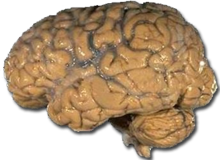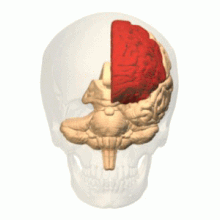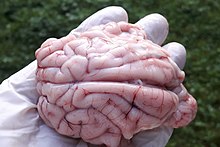Brain
![]()
This article deals with the part of the central nervous system of vertebrates located in the head. Further meanings are listed under brain.
The brain (Old High German hirni, hirne; Latin cerebrum, alone still technically Cerebrum and otherwise since 1901 further written in German Zerebrum) is the part of the central nervous system located in the head in vertebrates, including humans, and in some invertebrates. The brain, anatomically called encephalon or enkephalon (from the ancient Greek ἐγκέφαλος enképhalos as well as ἐν en, German 'in' and κεφαλή kephalē, German 'head'), lies protected in the cranial cavity, is enclosed by meninges and consists mainly of nervous tissue. At the level of the foramen magnum it merges with the spinal cord, both together forming the central nervous system (CNS).

Prepared human brain

Rotation animated model of a human brain (without right cerebrum; frontal lobe marked in red)
Vertebrate brain
Function
The vertebrate brain processes highly differentiated sensory perceptions and coordinates complex behaviors. It is thus the repository for most of the complex information that the organism processes.
Not all information reaches the cortex and leads to consciousness. Peripheral nerve plexuses and especially centers in the brainstem process most of the excitations arriving from receptors unconsciously. Reflex arcs take on tasks that are completed at top speed and without conscious processing or delaying influence. In humans, there is also such an autonomic nervous system. It coordinates autonomic functions such as respiration, cardiovascular system, food intake, digestion and output, fluid intake and excretion, and reproduction.
Highly interconnected neurons interact in the brain (see neural network and excitation conduction). Its activity is studied in vivo by measuring brain waves via electroencephalography (EEG) and the electric fields produced by the brain via magnetoencephalography (MEG).
Evolution
In the course of evolution, the brain of "higher" animals has achieved a considerable degree of differentiation and internal organization (cerebralization). This is reflected in the mental and physical development of the individual (see embryology). The structure and, to a lesser extent, the volume of the brain correlate with learning ability and intelligence. Only in the hierarchy of the nervous system is the performance of the brain understandable.
In addition to vertebrates, squid possess highly complex brains that enable them to perform directed activities. In a broader sense, it is the central part of the nervous system of various invertebrates, such as annelids or insects. Depending on the type of brain, it is either a cerebral ganglion or a superior cerebral ganglion. Two groups of invertebrates have particularly complicated brains: arthropods (insects, crustaceans, and others), and cephalopods (octopuses, squid, and similar mollusks). The brains of arthropods and cephalopods arise from two adjacent nerve cords. Cephalopods such as the octopus and squid have the largest brains of any invertebrate.
The highly developed brain of vertebrates differs markedly from the rope ladder nervous system of arthropods. In insects, the digestive tract passes directly through the anterior nervous system (between the tritocerebrum and the subesophageal ganglion), so that the abdominal ganglia lie ventral (abdominal side) to the intestinal tube, whereas in vertebrates the spinal cord lies dorsal (dorsal side) to the intestine.
Structure
Different criteria can be decisive for a classification of the brain, so that different classifications into brain areas are possible, which do not have to be mutually exclusive. For a classification of the adult human brain, it can also be quite useful to take into account the knowledge gained from the study of its developmental steps.
For example, in the ontogenetic development of the human brain, after the neurulation of the central parts of the neural plate to form the neural tube as the early embryonic anlage of the central nervous system, successive stages in the formation of the brain become apparent in the further course. Thus, after the closure of the anterior opening of the neural tube at the end of the fourth week of development, three so-called primary cerebral vesicles are initially formed from the anterior third of the neural tube, the anlagen of prosencephalon, mesencephalon and rhombencephalon. They develop differently, so that five secondary brain vesicles can be distinguished in the over five-week-old embryo - these lead to the division of the brain into five main sections: telencephalon (end brain), diencephalon (midbrain), mesencephalon (midbrain), metencephalon (hindbrain) and myelencephalon (medullary brain).
| Week 4 | Week 5 | Week 6 - End of life | Ventricular system | |||
| Brain | anterior neural tube | ProsencephalonForebrain | TelencephalonEndbrain | Lateral ventricles | Rhinencephalon, amygdala, hippocampus, neocortex, basal ganglia | |
| DiencephalonDiencephalon | Third ventricle | Thalamus dorsalis, | ||||
| MesencephalonMidbrain | MesencephalonMidbrain | mesencephalic aqueduct | Tectum (roof), | |||
| RhombencephalonRhomboid brain | MetencephalonHindbrain | Fourth ventricle | Pons (bridge), | |||
| MyelencephalonPosterior brain | Central Channel |
| ||||
The rough outline presented here follows the work of Pinel.

Brain of a roebuck approx. two hours after killing
Other
In 2008, the remains of a 2500-year-old human skull were found on the grounds of the University of York (England), with most of its brain preserved. Researchers suspect that the brain of the man, who was probably 26-45 years old, has been so well preserved to this day partly because the head - no body was found - was buried in wet clay immediately after death. A complete explanation as to why the brain did not decay long ago has not yet been found.
Brain as a raw material is used in fat tanning.
Neurolinguistics studies how language is represented, processed and learned by the brain.
For brain diseases, see for example Central nervous system#Diseases.
Questions and Answers
Q: What is the brain?
A: The brain is the part of the body which lets animals and humans think, and perform bodily functions, such as telling the rest of the body what to do. It gets input from sense organs, and changes behavior in response to this information. In humans, the brain also controls our use of language, and is capable of abstract thought.
Q: What does the brain control?
A: The brain is the main control centre of the whole body. It controls bodily functions such as movement, speech, emotions, memory and thinking.
Q: How is the brain made up?
A: The brain is made up of special cells called nerves, which are connected with each other and with other nerves in our body.
Q: How is it protected?
A: In all animals the brain is protected in some way. In ourselves, and all vertebrates, it is protected by the bones of the skull. In woodpeckers, for example, it is protected by their tongue which wraps around their brains.
Q: What does it do in humans?
A: In humans specifically, it controls our use of language and allows us to have abstract thought processes.
Q: Does it receive input from anywhere else?
A: Yes - it receives input from sense organs which helps inform its behaviour when responding to different stimuli or situations.
Search within the encyclopedia